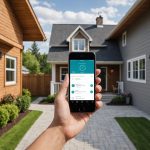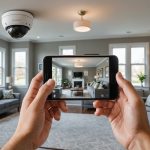Understanding Smart Home Security Systems
Smart home security systems are an essential component of modern home automation. These systems seamlessly integrate with various technologies to enhance the safety and security of your home. At their core, smart home security systems consist of a network of internet-connected devices that provide surveillance, detection, and alert capabilities.
Components
A typical system includes:
In parallel : Enhancing Smartwatch Fitness Tracking: Innovative Techniques for Better Accuracy
- Surveillance Cameras: Capture and stream live footage.
- Motion Sensors: Detect unusual movements.
- Door/Window Sensors: Alert when opened unexpectedly.
- Smart Alarms: Notify homeowners of intrusions or emergencies.
Benefits
Integrating smart technology into your home enhances security, providing real-time monitoring and remote control via your smartphone. It allows you to receive instant alerts about security breaches, making it more effective than traditional systems. Furthermore, some systems offer automation features like turning on lights when motion is detected, adding an extra layer of deterrence against intruders.
Compatibility
Smart home security systems are designed to work seamlessly with smartphones and other devices, allowing for easy control and monitoring. Whether you own an iPhone, Android, or a tablet, you can manage your security settings, check live footage, and receive notifications anywhere, anytime, ensuring your home is always protected.
Also read : Your Ultimate Guide to Installing a Smart Home Surveillance System with Your Smartphone
Preparing for Installation
Embarking on the path to enhanced home security starts with thorough installation preparation. First, evaluate your current security needs and future goals. Ask yourself questions like: What are your primary security concerns? Which areas need protection? This clarifies the direction, allowing for strategic planning and prioritisation.
Conduct a compatibility check with your smartphone. Many security systems rely on smartphone connectivity for monitoring and control. Check if your device supports the necessary apps and features, and ensure your operating system is up-to-date to prevent potential compatibility issues during installation.
Before beginning, gather the tools and materials you’ll need. These often include a drill, screwdriver, level, and the specific security needs you aim to address through your device. Check the installation manual for any additional, specialised items that may be required.
In facilitating a smooth setup, confirm all components of the security system are present and functional before installation begins. Inspect sensors, cameras, and control panels for any signs of damage or malfunction. This proactive approach mitigates delays and ensures your security solution is both efficient and effective for your home. Merging forethought with methodical action paves the way for a successful installation, reinforcing your home’s protective measures.
Step-by-Step Installation Guide
Navigate the world of Smart Security Installation with ease by following this comprehensive guide.
Setting Up the Central Hub
Start by choosing a location for your central hub that allows seamless connectivity to other devices. Make sure it’s near a power outlet and your Wi-Fi router to maintain a strong network connection. Plug in the hub and follow the manufacturer’s instructions for the initial setup. This usually involves downloading the accompanying mobile app, creating an account, and getting the hub online. A successful setup ensures your hub communicates with all connected devices.
Installing Cameras and Sensors
When installing cameras, consider angles of view to cover all vulnerable areas of your property. Use suitable mounts to secure cameras at ideal heights for optimal coverage. For sensors, follow the guidelines in the setup process, placing them on doors and windows. Ensure every device is securely fixed, powered (batteries or wired as required), and within range of the central hub to guarantee reliable operation.
Configuring Mobile Apps
Once all devices are set, synchronize them with the setup process using the mobile app. Open the app, add new devices by following the on-screen instructions, and ensure all elements are linked. Enable notifications, set your preferences and ensure everything works harmoniously for efficient real-time monitoring of your home security system. Recheck connections if the apps don’t reflect the correct settings.
Troubleshooting Common Issues
When dealing with connectivity issues, first verify your device is correctly connected to the network. Check if you are within range and that your router is functioning properly. Make sure network settings are compatible with your device’s requirements. Resetting the connection or restarting the router can often resolve these problems swiftly.
For app-related problems, ensure that your app is updated to the latest version. Clear the app cache to eliminate any corrupted data. If these steps do not help, uninstalling and reinstalling the app may resolve the issue. Regularly check for software updates, as these can provide critical fixes and improvements to app performance.
Maintaining optimal device functionality involves several best practices. Ensure that your device’s firmware is always up-to-date, as this can prevent unexpected failures. Perform periodic maintenance such as cleaning device components and updating software to keep operations seamless. If performance declines, consider performing a hard reset to refresh the system.
By following these tips and remedies, you can tackle most challenges effectively, ensuring your technology remains reliable and efficient. Addressing common problems promptly can make a significant difference in maintaining a smooth user experience.
Maximizing Smartphone Integration
In today’s tech-savvy world, smartphone integration plays a pivotal role in enhancing the functionality of smart devices. With remote monitoring, users can now stay connected to their devices wherever they are. By utilizing dedicated mobile apps, real-time alerts are readily available, ensuring timely notifications and updates. This feature significantly reduces any lag in communication, offering a seamless user experience.
A major advantage of this integration revolves around user-friendly features that allow users to customize settings for alerts and notifications based on their individual needs. This flexibility empowers users to tailor their experiences to align with their daily habits and preferences, making life simpler and less stressful. For instance, setting specific alert tones for different notifications can help differentiate the urgency of messages you receive from your smart devices.
Moreover, integrating these smart devices with other smart home systems brings additional benefits, particularly for those concerned with enhanced security. By linking various smart gadgets through a unified platform, users can experience a cohesive and well-coordinated home security system. For example, smart lights can be programmed to turn on if a security alert is triggered. This interconnectivity not only enhances the security of one’s home but also provides peace of mind, knowing that everything is under control, even when away.
Product Recommendations
Finding the right security products can enhance your home’s safety and your peace of mind. The best smart security devices offer advanced features, making them essential investments for any household prioritising security.
Recommended Security Cameras
Security cameras have evolved significantly, providing sharper images and smarter functionality. Cameras reviewed under the latest models have shown impressive night vision, reliable motion detection, and easy integration with other smart devices. Brands renowned in product reviews include Arlo and Nest, which offer high-definition video and user-friendly apps. These cameras not only record suspicious activity but can also send instant alerts to your smartphone.
Best Smart Doorbells
Smart doorbells combine traditional functionality with modern technology, adding a layer of security to your entryway. Key features from product reviews focus on visitor recognition, live video streaming, and two-way audio. Brands like Ring and Eufy are noted for reliability and feature-rich options. They enable homeowners to interact with visitors remotely, enhancing security and convenience.
Top Security Systems
Comprehensive security systems incorporate various devices to create a well-rounded safety net for residences. Product reviews highlight systems with centralized control, including motion sensors, alarms, and backup options. Compare systems from ADT, SimpliSafe, and Vivint to find one that perfectly matches your needs, offering scalability and seamless integration with smart home ecosystems.
Benefits of Smart Home Security
Smart home security systems offer significant enhancements in home safety thanks to cutting-edge smart technology advantages. These systems use advanced technologies such as motion sensors, real-time alerts, and automated locks to boost security measures. By immediately detecting unusual activities and sending instant alerts, homeowners are provided with both safety and peace of mind.
Smart security systems provide convenience by allowing users to manage everything remotely via their smartphones. Whether at work or on vacation, you can monitor your home, lock doors, and view security cameras with a tap on your phone. This remote accessibility means you no longer have to worry about forgetting to lock the house or missing a potential threat; you have control with just a few swipes.
The integration of smart solutions can also be cost-effective. While initial investments may seem high, their long-term benefits make them worthwhile. Smart systems can reduce insurance premiums, minimise the risk of theft, and spare you the expense of potential damages because they are proactive rather than reactive. In sum, the adoption of smart technologies in home security systems not only bolsters safety but also delivers convenience and financial benefits.











